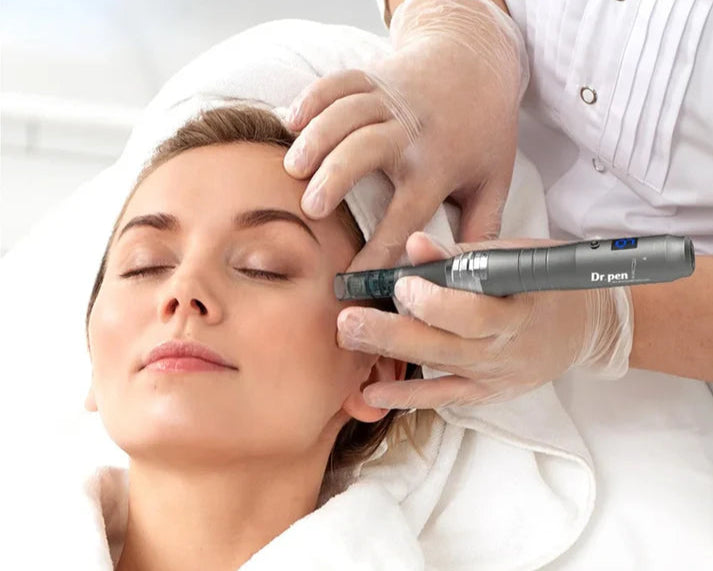Melasma, often referred to as the "mask of pregnancy" due to its prevalence during pregnancy, is a common skin condition characterized by symmetrical, dark, and irregular patches on the face. Primarily affecting women, melasma can be a source of significant distress, impacting self-esteem and quality of life. The condition typically appears on the cheeks, bridge of the nose, forehead, and chin, and can be exacerbated by sun exposure, hormonal changes, and genetic predisposition.

Traditional treatments for melasma include topical creams, chemical peels, and laser therapy. However, these methods can sometimes be ineffective, costly, or associated with side effects such as skin irritation and hyperpigmentation. As a result, individuals with melasma are increasingly turning to alternative therapies, one of which is microneedling.
Microneedling, also known as collagen induction therapy, involves the use of a device equipped with fine needles to create controlled micro-injuries on the skin's surface. This process stimulates the body's natural healing response, promoting the production of collagen and elastin. While microneedling has gained popularity for its potential to improve skin texture, reduce scars, and minimize pores, its efficacy in treating melasma is a topic of considerable interest.
One of the primary tools used in microneedling is the microneedling pen. This handheld device features adjustable needle lengths, allowing practitioners to tailor treatments to individual needs. The needles penetrate the skin at a depth ranging from 0.5 to 2.5 millimeters, depending on the area being treated and the desired outcome. The procedure is relatively quick, with sessions lasting anywhere from 15 to 30 minutes, and can be performed in a clinical setting or even at home with the appropriate training and equipment.
So, can a microneedling pen help with melasma? The answer lies in understanding the underlying mechanisms of melasma and how microneedling might influence them. Melasma is believed to result from an overproduction of melanin, the pigment that gives skin its color. This overproduction is triggered by a combination of genetic, hormonal, and environmental factors. Microneedling, by creating micro-injuries in the skin, is thought to disrupt the melanin-producing cells (melanocytes) in the affected areas.
When the skin is injured, it initiates a wound healing response. This response involves the migration of immune cells to the site of injury, the production of growth factors, and the synthesis of new collagen and elastin fibers. In the context of melasma, this process could potentially lead to a reduction in melanin production as the skin heals and regenerates. Additionally, microneedling can enhance the penetration of topical treatments, allowing active ingredients to reach deeper layers of the skin where they can be more effective.
Several studies have investigated the use of microneedling for melasma, with promising results. One study published in the Journal of Dermatological Treatment found that microneedling combined with a topical depigmenting agent was more effective than the topical agent alone in reducing melasma severity. Another study, published in the Journal of Cosmetic Dermatology, reported significant improvements in melasma after a series of microneedling sessions.
However, it is important to note that microneedling is not a one-size-fits-all solution for melasma. The effectiveness of the treatment can vary depending on factors such as the depth of needle penetration, the number of sessions, and the individual's skin type and response to treatment. Furthermore, microneedling carries some risks, including infection, skin irritation, and post-inflammatory hyperpigmentation, particularly in individuals with darker skin tones.
To minimize these risks and maximize the benefits of microneedling for melasma, it is crucial to follow a few key guidelines. First, microneedling should only be performed by a trained and experienced professional. Attempting to use a microneedling pen at home without proper training can lead to complications and suboptimal results. Second, the skin should be thoroughly cleansed and prepared before the procedure to reduce the risk of infection. Third, a high-quality, medical-grade topical depigmenting agent should be applied to the skin immediately after microneedling to enhance the treatment's effectiveness.
In addition to these guidelines, individuals considering microneedling for melasma should be aware of the potential for side effects and the need for multiple sessions to achieve noticeable results. It is also important to maintain realistic expectations. While microneedling can significantly improve the appearance of melasma, it may not completely eliminate the condition. Regular maintenance treatments may be necessary to sustain the improvements over time.
Moreover, sun protection is paramount when treating melasma with microneedling or any other method. Sun exposure is a major trigger for melasma, and failing to protect the skin from ultraviolet rays can undermine the effectiveness of the treatment and lead to a recurrence of the dark patches. Therefore, individuals with melasma should wear a broad-spectrum sunscreen with an SPF of at least 30 daily, avoid sun exposure during peak hours, and wear protective clothing and hats when outdoors.
In conclusion, a microneedling pen can be a valuable tool in the management of melasma when used appropriately and in combination with other treatments. By stimulating the skin's natural healing response and enhancing the penetration of topical depigmenting agents, microneedling has the potential to reduce the severity of melasma and improve skin appearance. However, the treatment should be performed by a qualified professional, and individuals should be aware of the potential risks and the need for multiple sessions and ongoing sun protection. With careful consideration and proper management, microneedling can be a safe and effective addition to the arsenal of therapies available for the treatment of melasma.

Share:
How to Choose a Microneedling Pen with LED Light Therapy
Can a Microneedling Pen Help with Skin Tightening?